Gangtok, the enchanting capital of Sikkim, lies hidden among the mighty Himalayas on the border with China, Bhutan, and Nepal. This medium-sized mountain town is the perfect starting point for adventures through North and West Sikkim. But don’t underestimate Gangtok itself, the city offers a fascinating mix of Buddhist monasteries, spectacular mountain panoramas, and a surprisingly clean, modern atmosphere.
In this article, I’ll take you through all the highlights that make Gangtok an unforgettable destination.
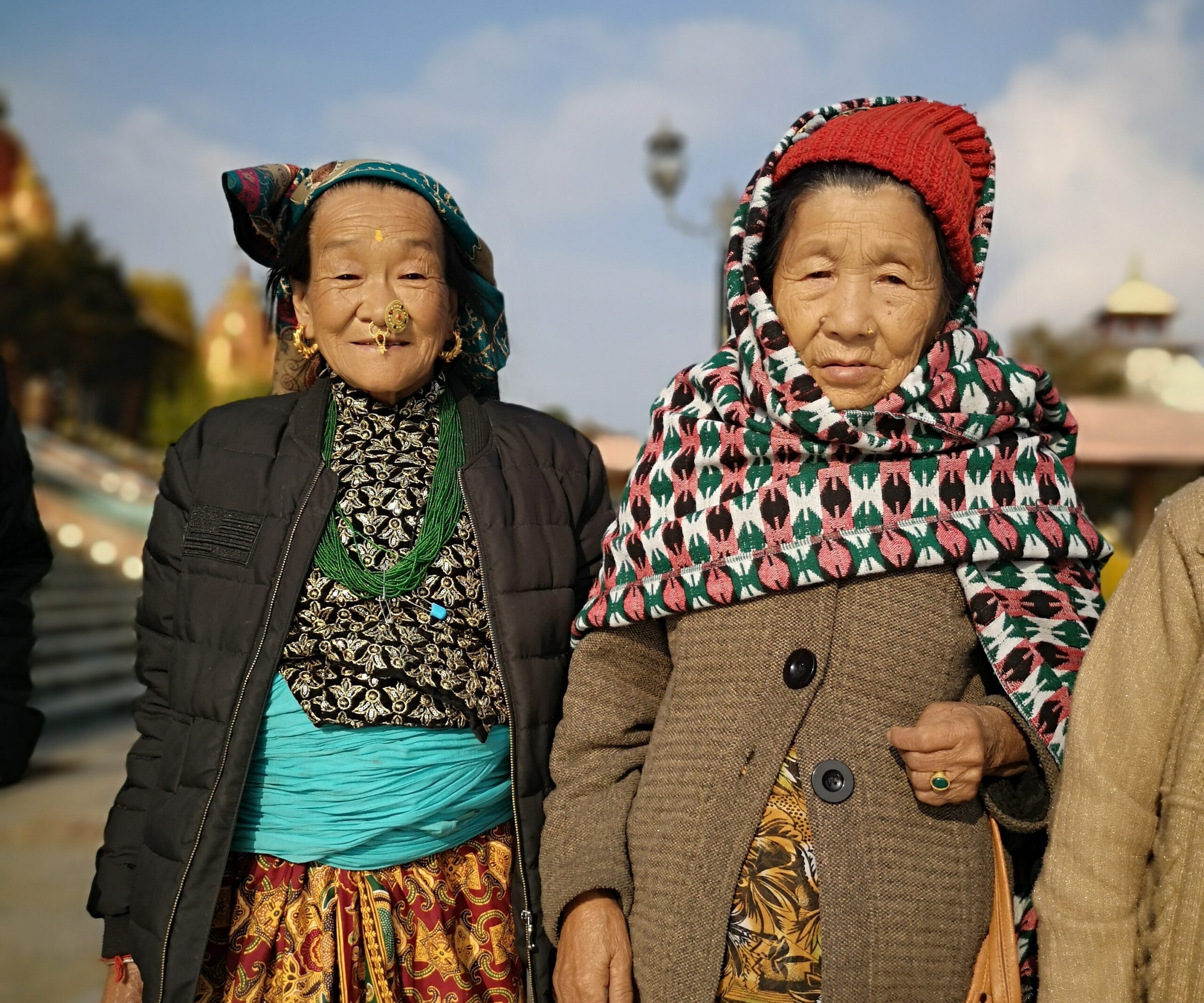
The People, The Views: Gangtok Sikkim Surprises You in Every Way
I stayed my first night at the cozy hostel Tagalong Backpackers, and the next day I set out with fellow blogger Abhinav Singh from A Soul Window to explore the highlights around Gangtok. Jitaditya from The Travelling Slacker joined us a day later. This was the start of a 10-day trip offered to us by Sikkim Cab Rental Co.
Practical Information: Before You Go
Permits and Access to Sikkim
Before traveling to Sikkim, it’s important to know that all foreigners need a special permit. Fortunately, this is easy to arrange, you only need a passport photo, a copy of your passport, and your India visa. The costs are minimal.
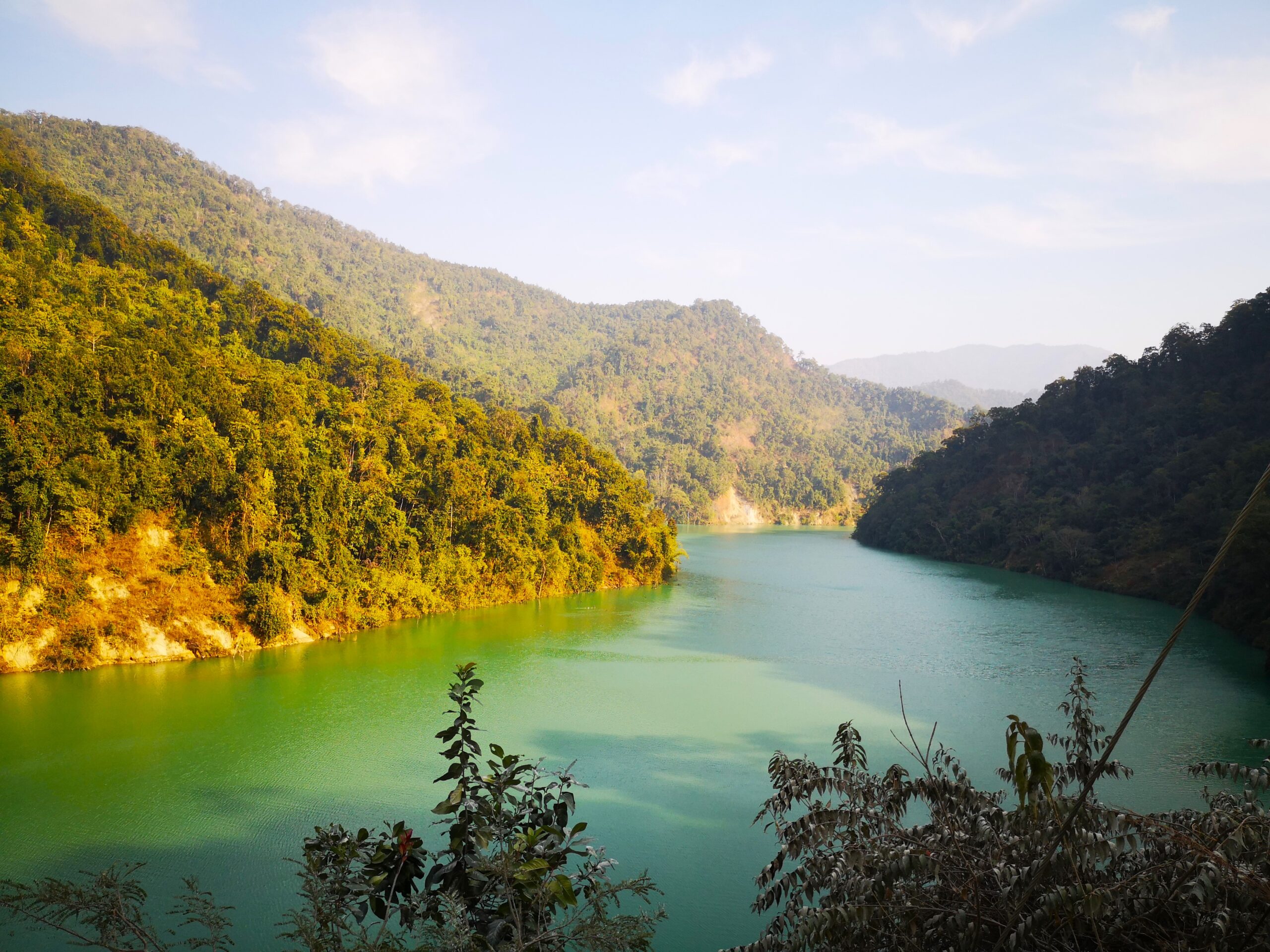
Due to the strategic location on the Chinese border, strict rules apply. Certain areas in Sikkim are off-limits to foreigners due to security concerns. A remarkable detail: some Indian citizens, such as Sikhs, also have limited access to specific locations, such as certain sacred lakes, out of fear of religious claims.
How to Get to Gangtok
The most common route is flying to Bagdogra in West Bengal, followed by a spectacular 130-kilometer drive to Gangtok. Allow about 4 hours of driving, but take your time – the route offers breathtaking views.
Must-Stop En Route: Coronation Bridge
This impressive white bridge, built by the British, is an iconic landmark. Stop here to take in the surroundings, taste a local momo, and of course take photos of the bridge and the beautiful Teesta Valley near Kalimpong.
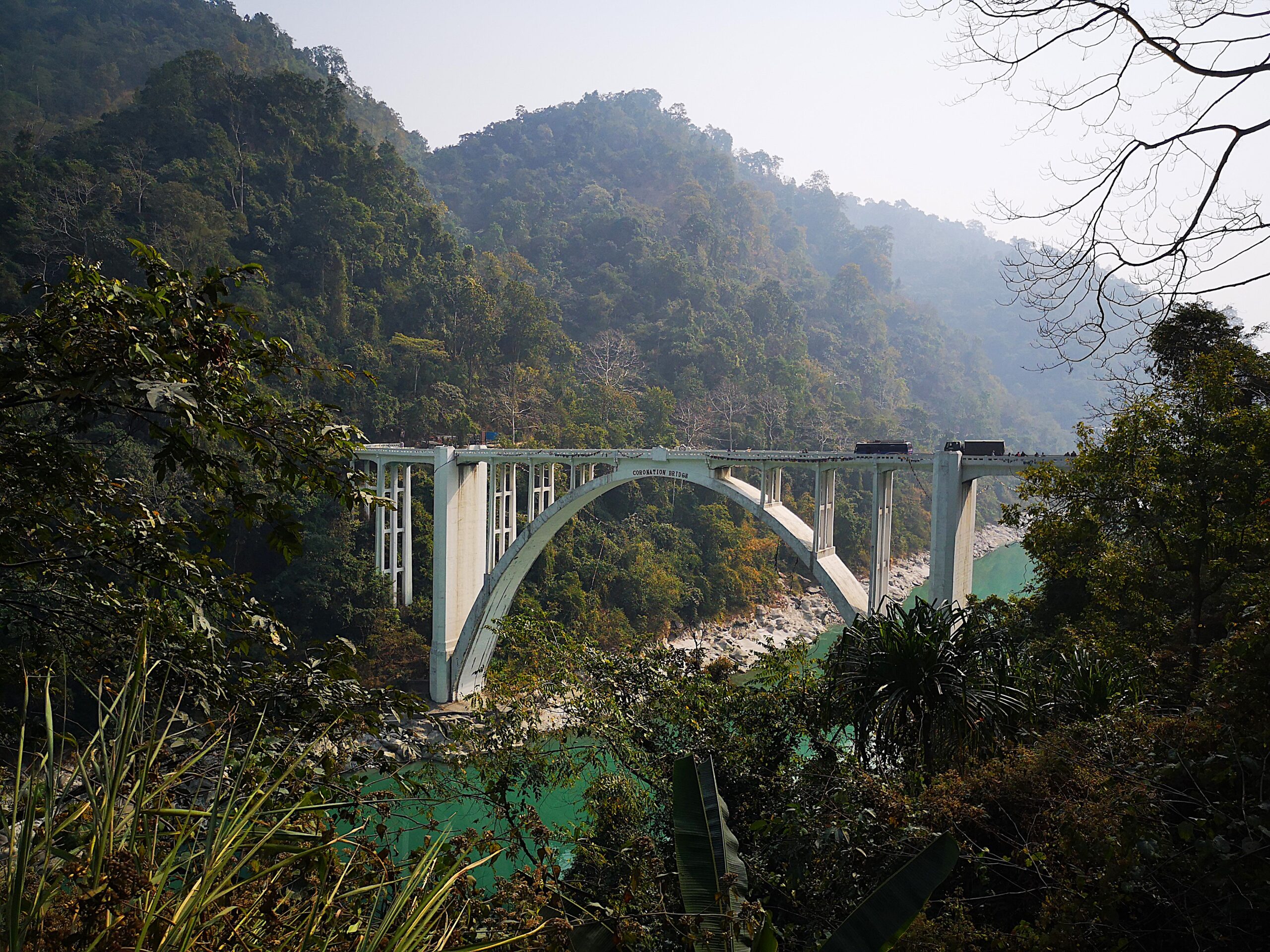
The Monasteries and Temples of Gangtok
Gangtok is steeped in spirituality. The mountains surrounding the city are dotted with Buddhist monasteries and Hindu temples, each with their own unique atmosphere and spectacular views.
Hanuman Tok / Hanuman Mandir
Start your day early at this temple dedicated to Hanuman. In January it can still be chilly in the morning, but as soon as the sun breaks through, it becomes delightful. Note: as with all temples in India, you must remove your shoes before entering the grounds.
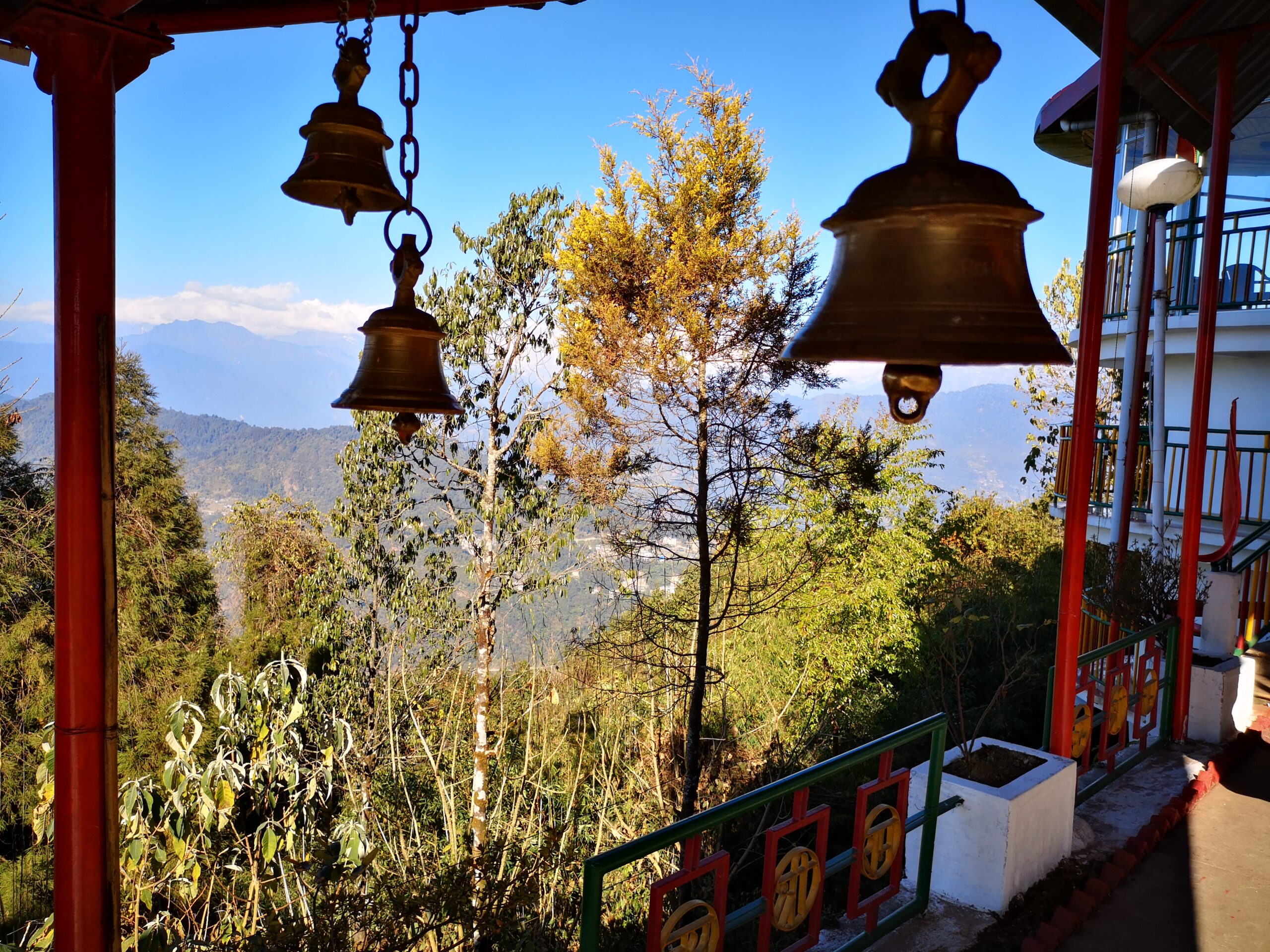
A special moment: on the way up, you ring the bells that announce your arrival. The sound echoes through the stairwell and creates a meditative atmosphere that connects you with ancient traditions. And just look at that background! I can’t get enough of it and take many photos of the views, soaking up the atmosphere. And… I forget to take good photos of this beautiful Hanuman temple.
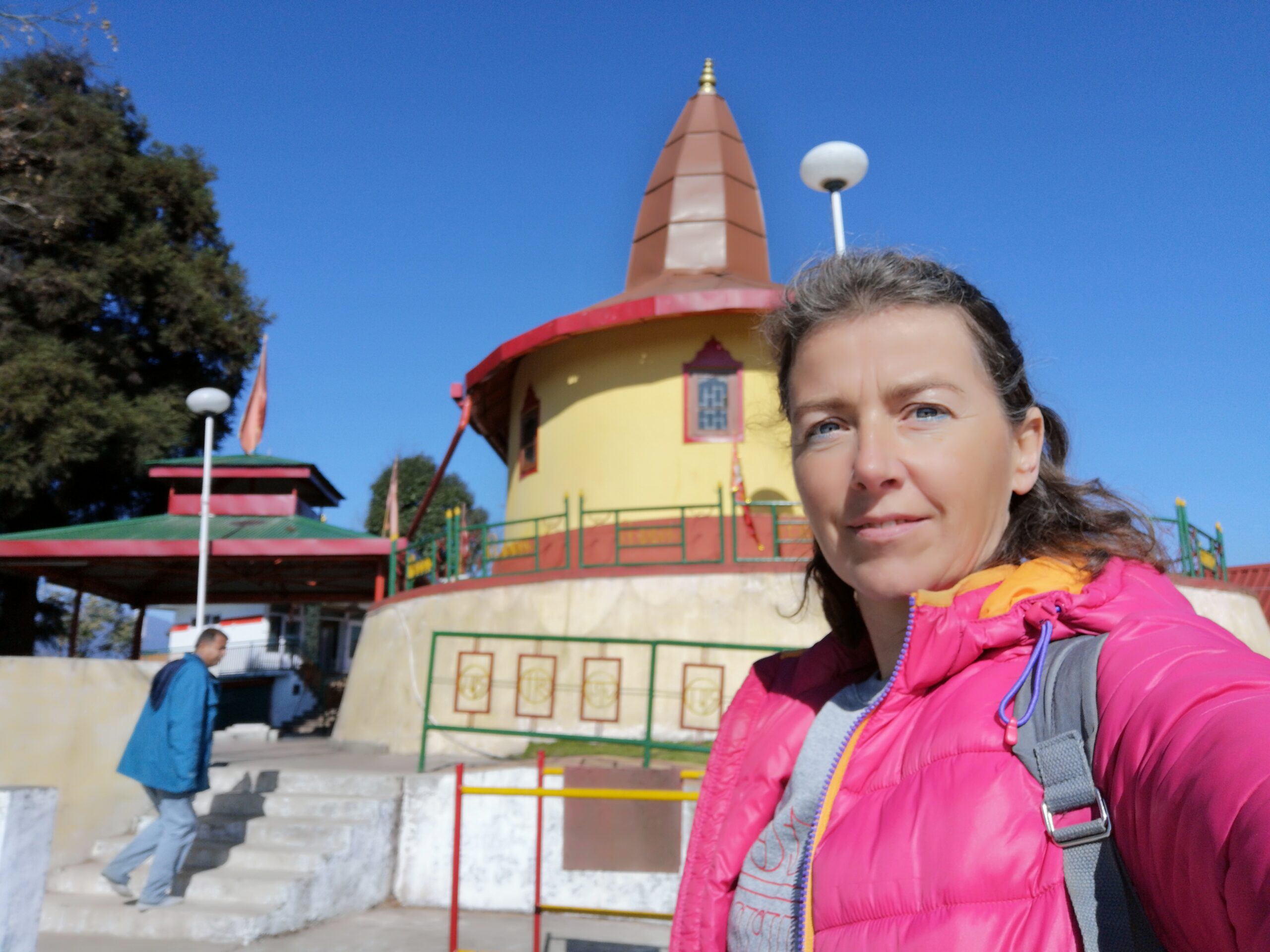
Ganesha Tok / Ganesha Mandir
This temple, dedicated to Ganesha, sits higher on the mountain and offers even more impressive panoramas. Plenty of photos are taken here, and yes, I love posing with the locals… if I can get a photo too! 🙂
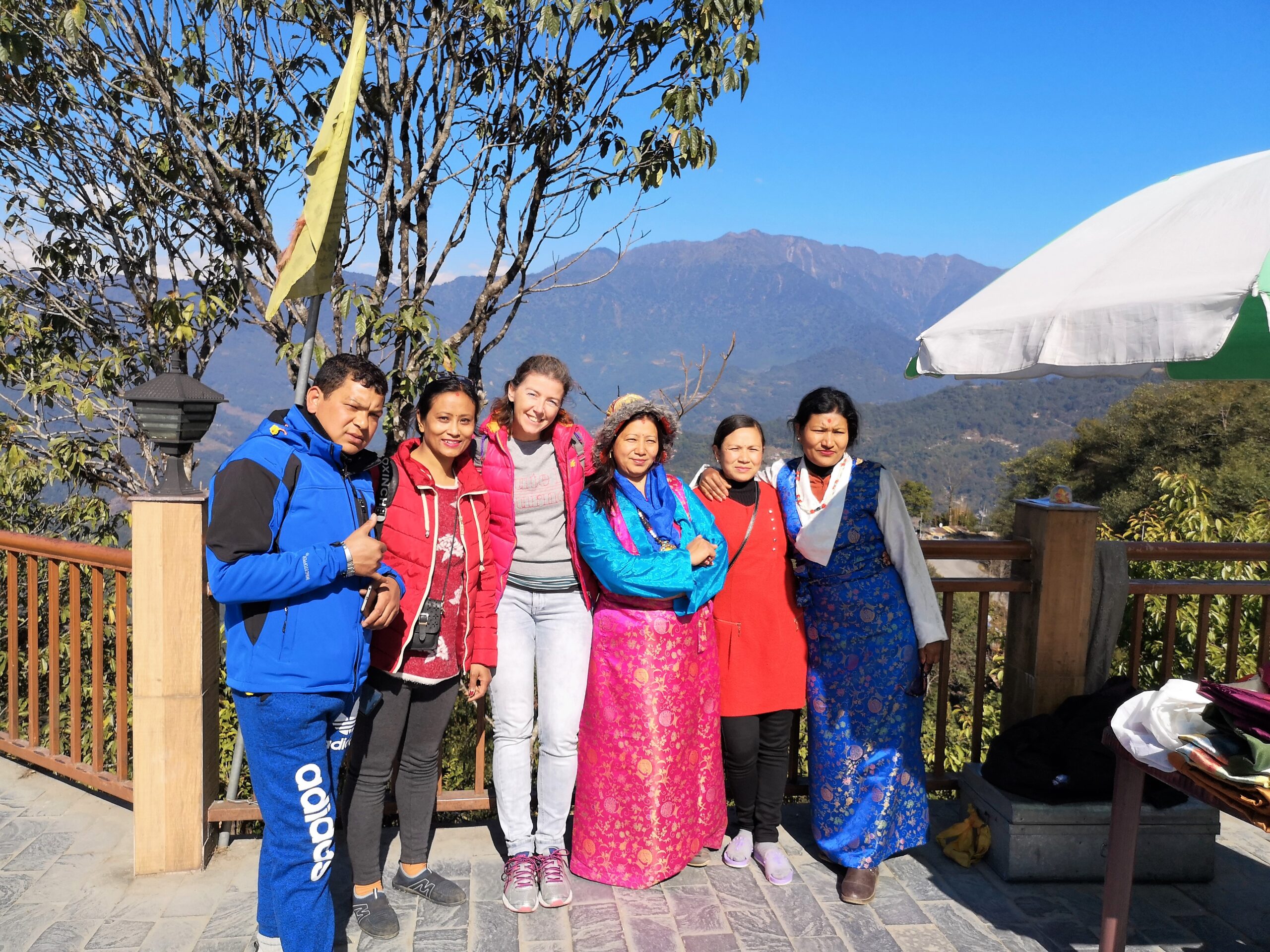
Temple with Views of Kanchenjunga
The absolute highlight is the highest temple where, in clear weather, you can see the third-highest mountain in the world: Kanchenjunga (8,586 meters). The panorama with this colossal mountain peak and the surrounding summits is truly unforgettable. Nepalese communities especially come here to pray, reflecting Sikkim’s cultural diversity.
About Kanchenjunga: This sacred mountain forms the border between Nepal and Sikkim and is not just a geographical phenomenon, but also a spiritual protector for local communities. The name comes from four Tibetan words meaning “The Five Treasures of the Great Snow,” referring to five peaks said to contain gold, silver, gems, grain, and sacred scriptures.
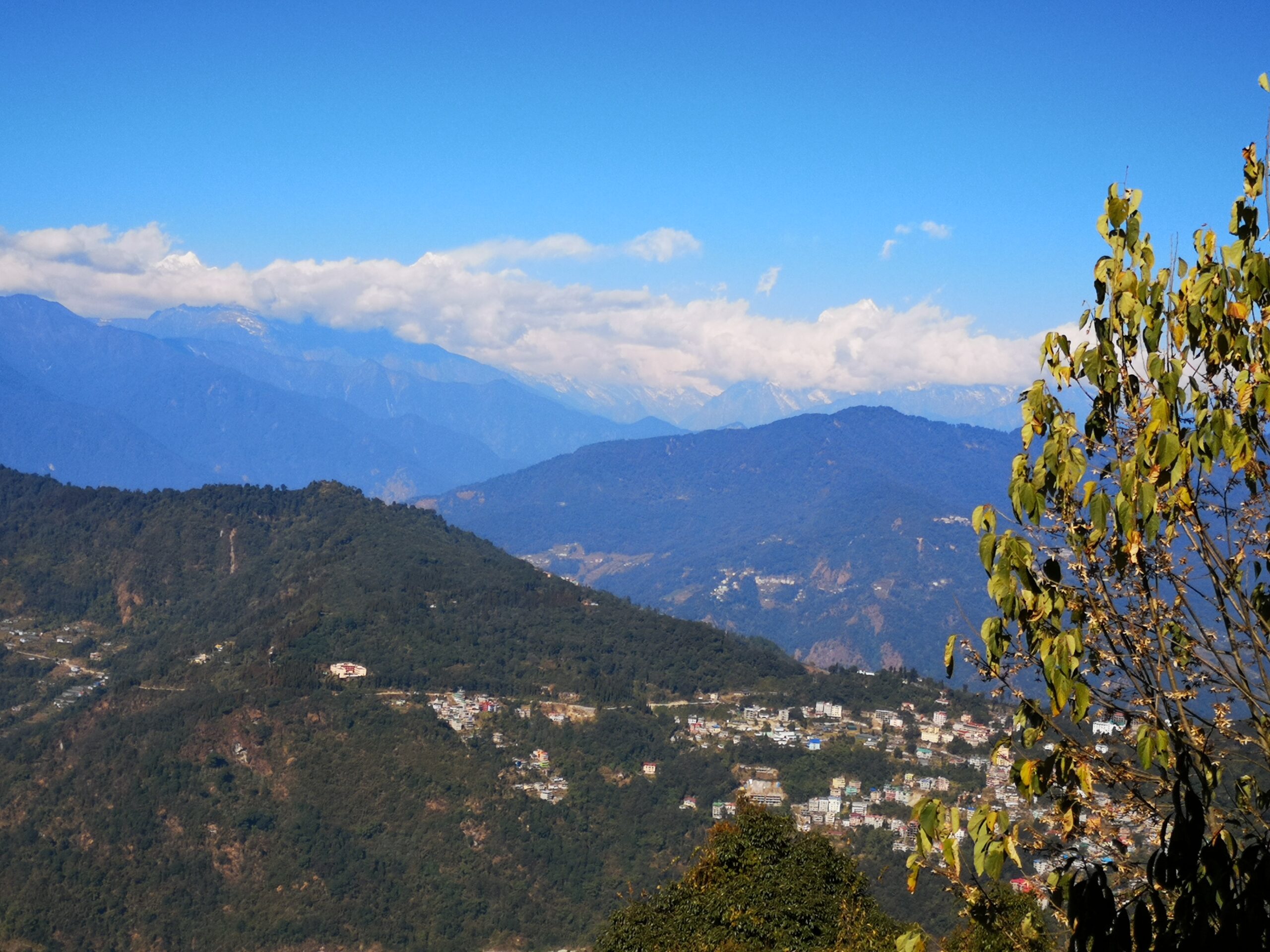
Gonjang Monastery
This peaceful monastery offers an authentic glimpse into the daily life of Buddhist monks.
Enchey Monastery
One of the most atmospheric monasteries in the Gangtok area, where you can experience the tranquility of monastic life. I loved walking around and soaking up the atmosphere of life in a monastery. It’s something that intrigues me but is so far removed from my own life.
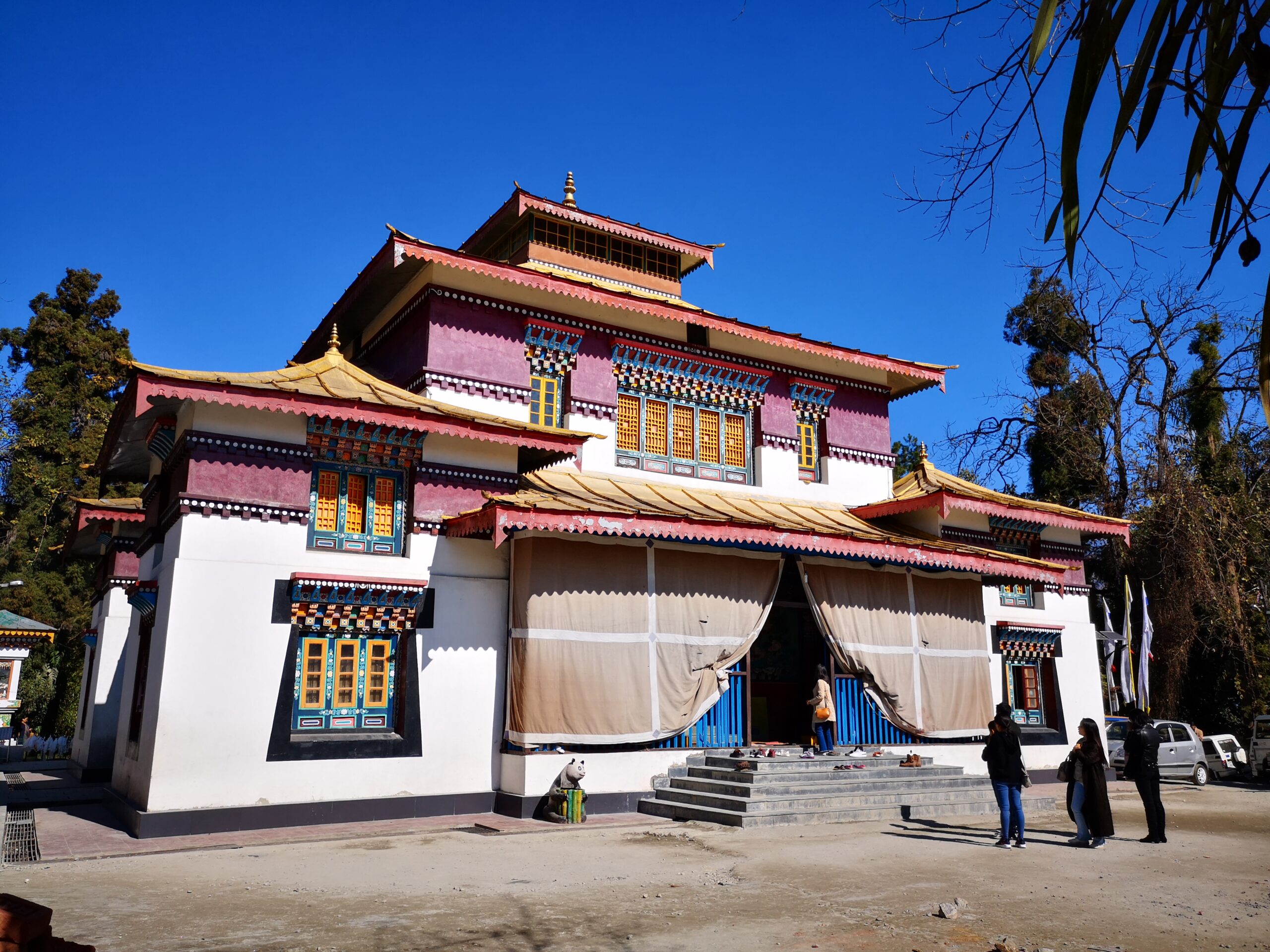
Rumtek Monastery: Absolute Must-Visit
About 1.5 hours outside Gangtok lies the impressive Rumtek Monastery. The drive there is an experience in itself – winding mountain roads through breathtaking landscapes, with colorful Buddhist prayer flags fluttering in the wind everywhere. These flags, which you’ll also find in Nepal, give the area a mystical atmosphere.
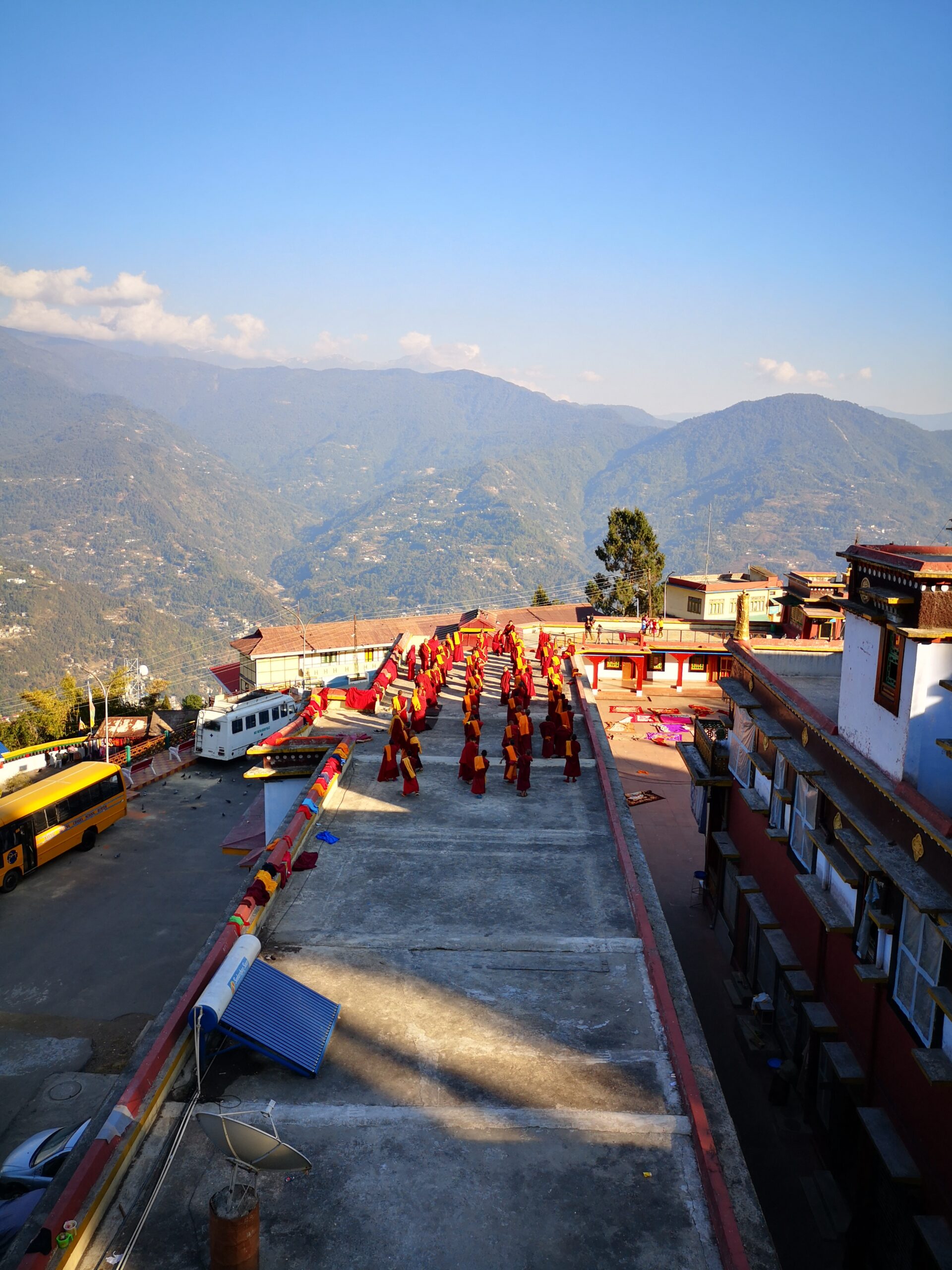
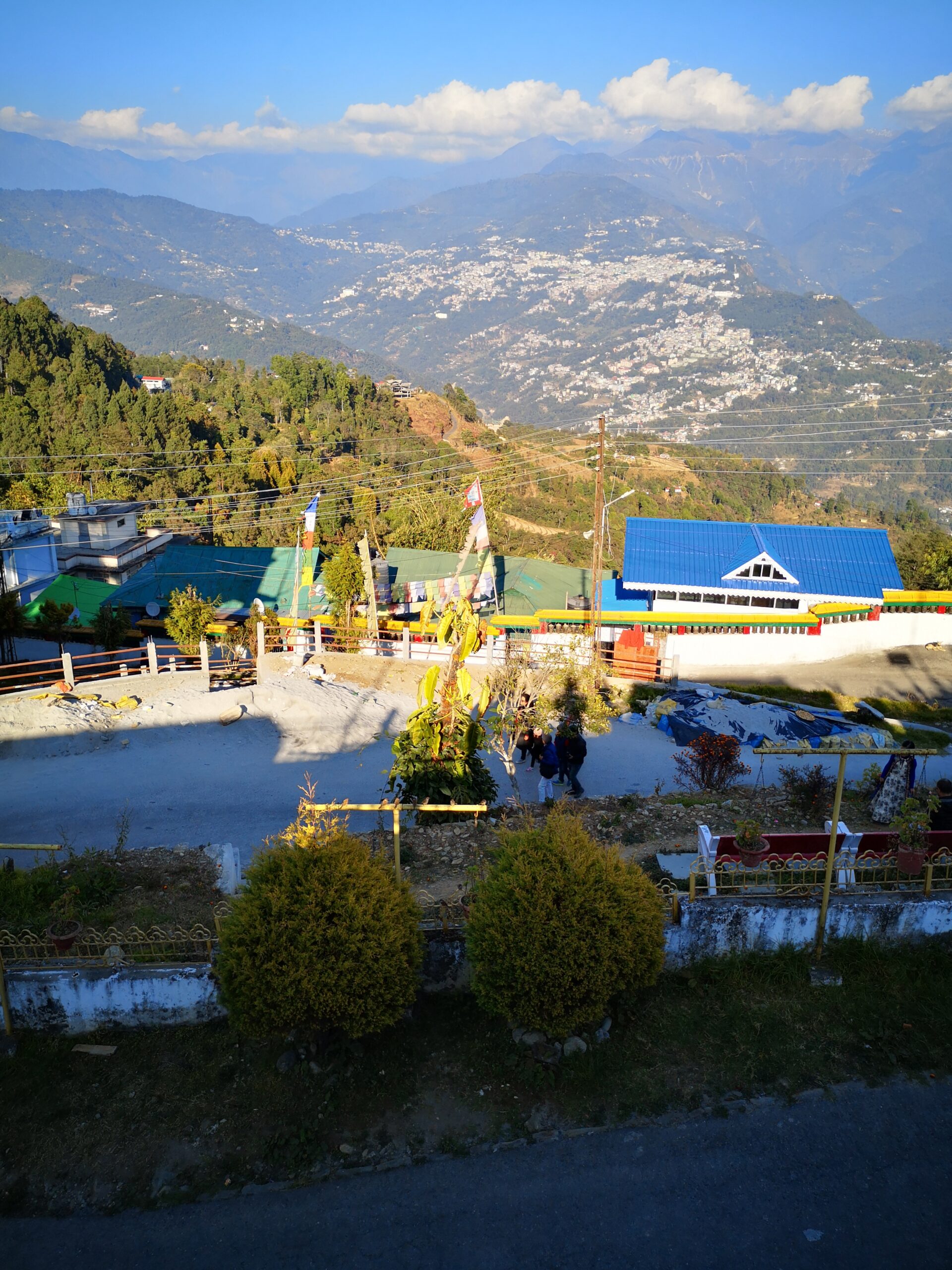
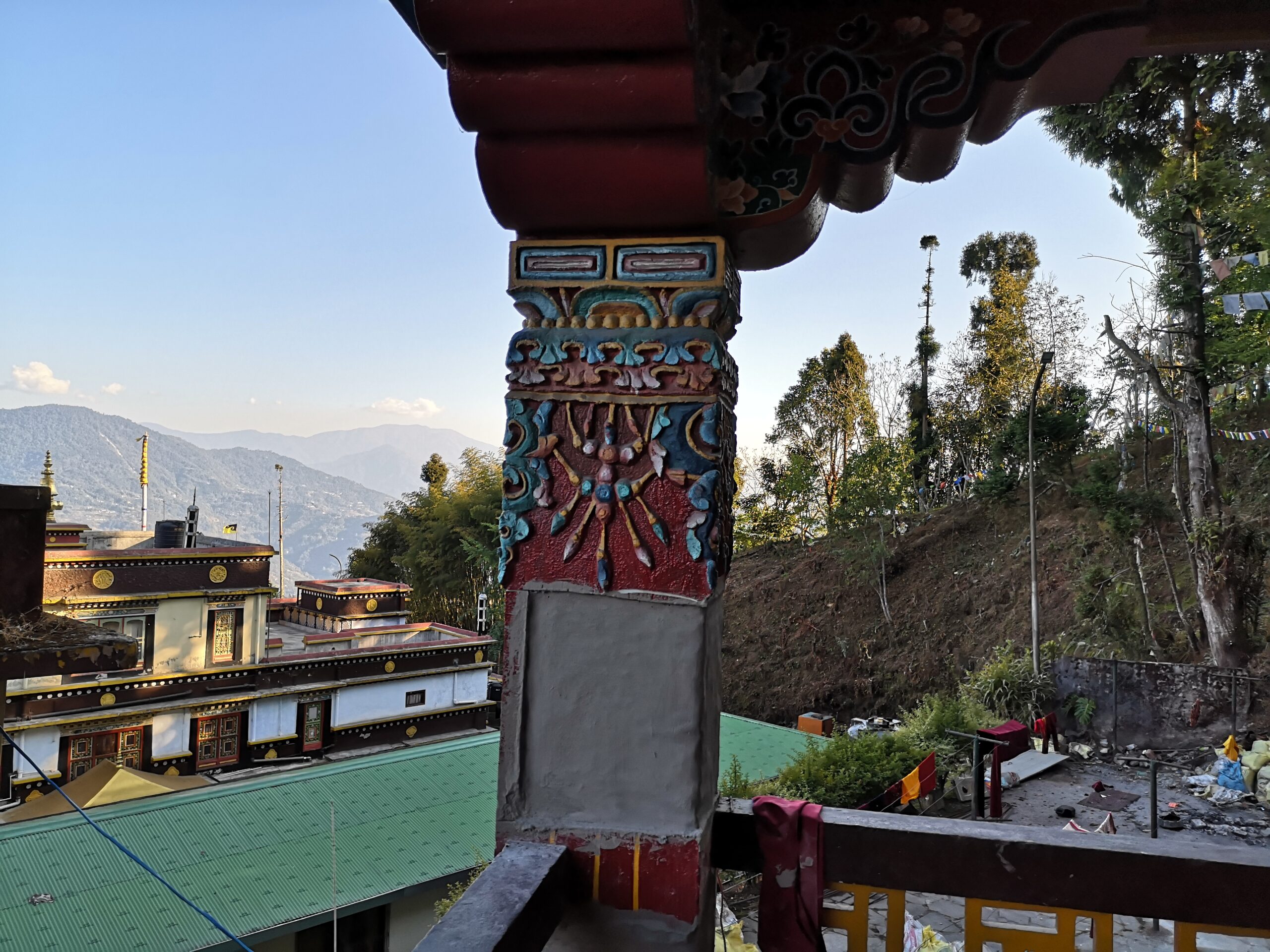
Historical Context: The original Rumtek Monastery was founded in 1740 (16th century) by Wangchuk Dorje, the 9th Karmapa Lama, and served as the main seat of the Karma Kagyu lineage in Sikkim. When Rangjung Rigpe Dorje, the 16th Karmapa, fled Tibet in 1959 after the Chinese invasion, he found the monastery in ruins. Despite offers for other locations, he chose to rebuild Rumtek.
An Unexpected Moment: At the monastery in Rumtek, I experienced something I’ll never forget. While peering through a small kitchen window at a courtyard below, we saw 15 to 20 monks who had just finished meditating, neatly seated in a row at equal distances from each other. To our amazement, two monks suddenly got into a fight, one clearly lost and the other even threw a stone at him! The other monks simply let it happen.
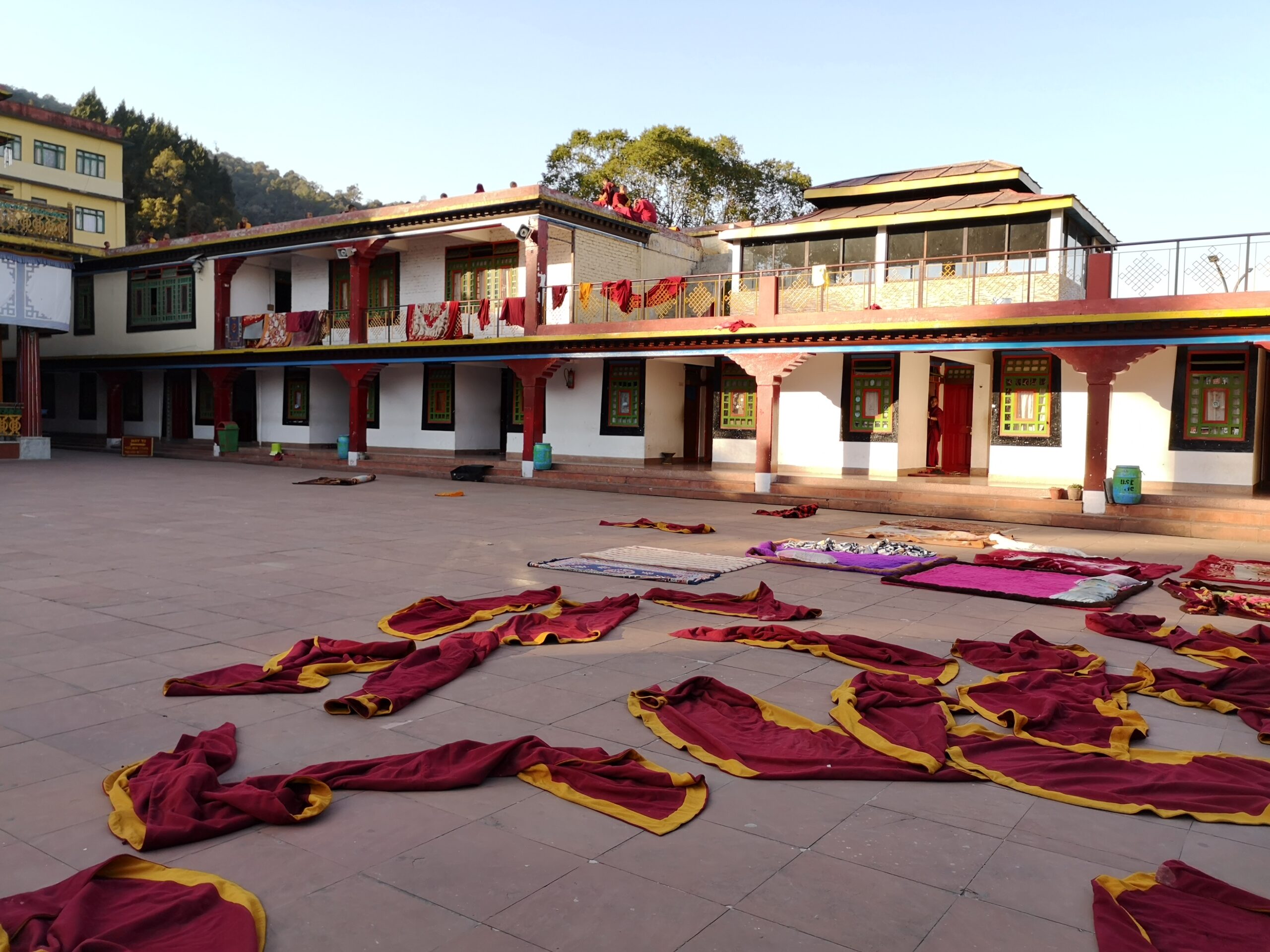
A scene that briefly disrupted the romantic image of peaceful monastic life and also showed the human side of this spiritual community.
What to See:
- The Golden Stupa: Contains the relics of the 16th Karmapa and is decorated with gold and precious stones
- Main Prayer Hall: A spacious, intricately decorated hall supported by robust red pillars, with a 3-meter-tall statue of Sakyamuni Buddha
- Murals: Vibrant frescoes in traditional Tibetan monastery style, including depictions of the Four Protectors of the Universe
- Karma Shri Nalanda Institute: A Buddhist college for higher studies, located opposite the monastery
- Kora Walking Path: A walking path around the monastery where monks, pilgrims, and visitors make their ritual circuit
Natural Beauty and Green Spaces
Waterfalls Around Gangtok
Gangtok is surrounded by beautiful waterfalls. Some are easily accessible from the road, where local vendors offer fresh fruit – a perfect combination of natural beauty and local culture.
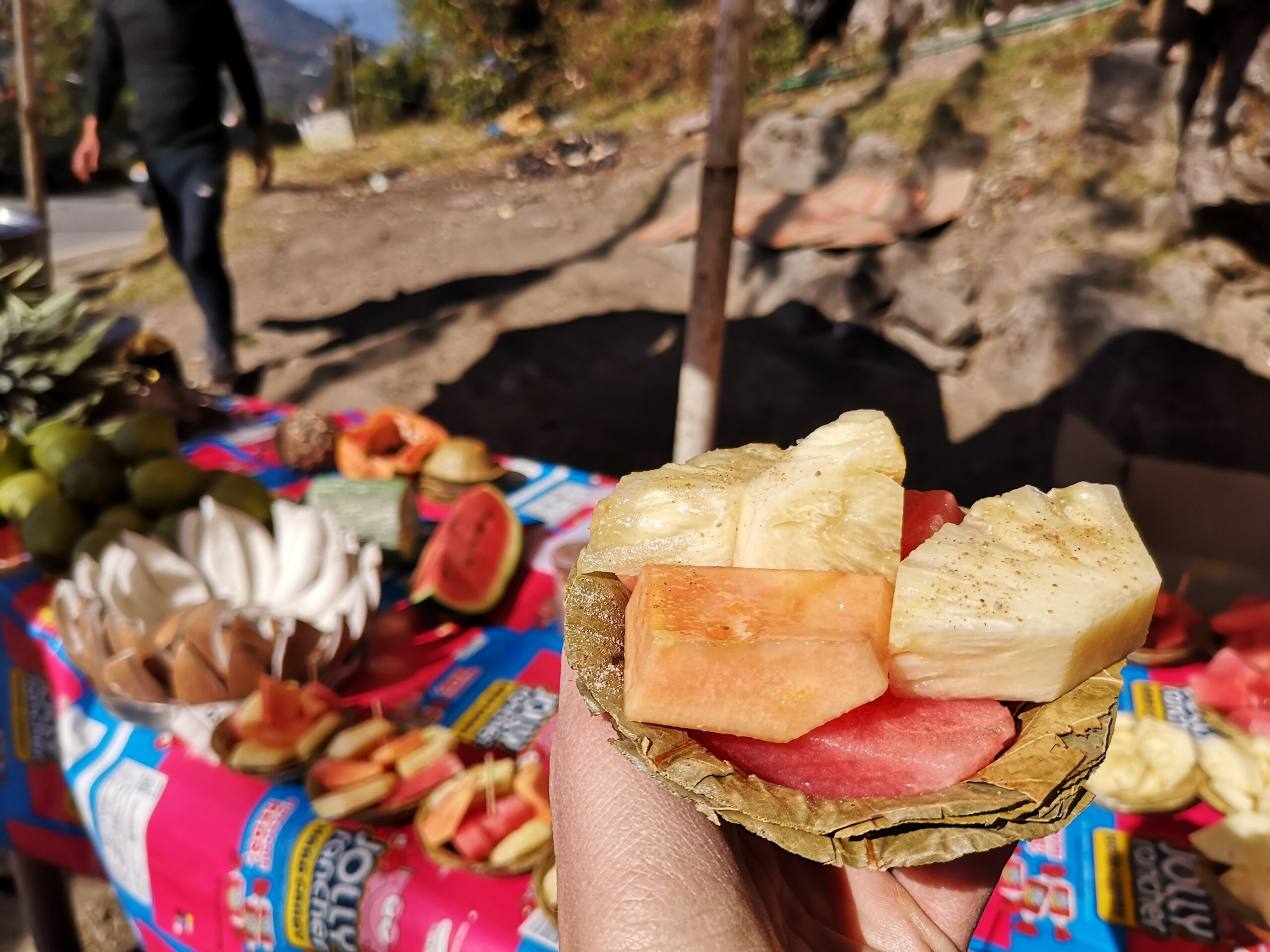
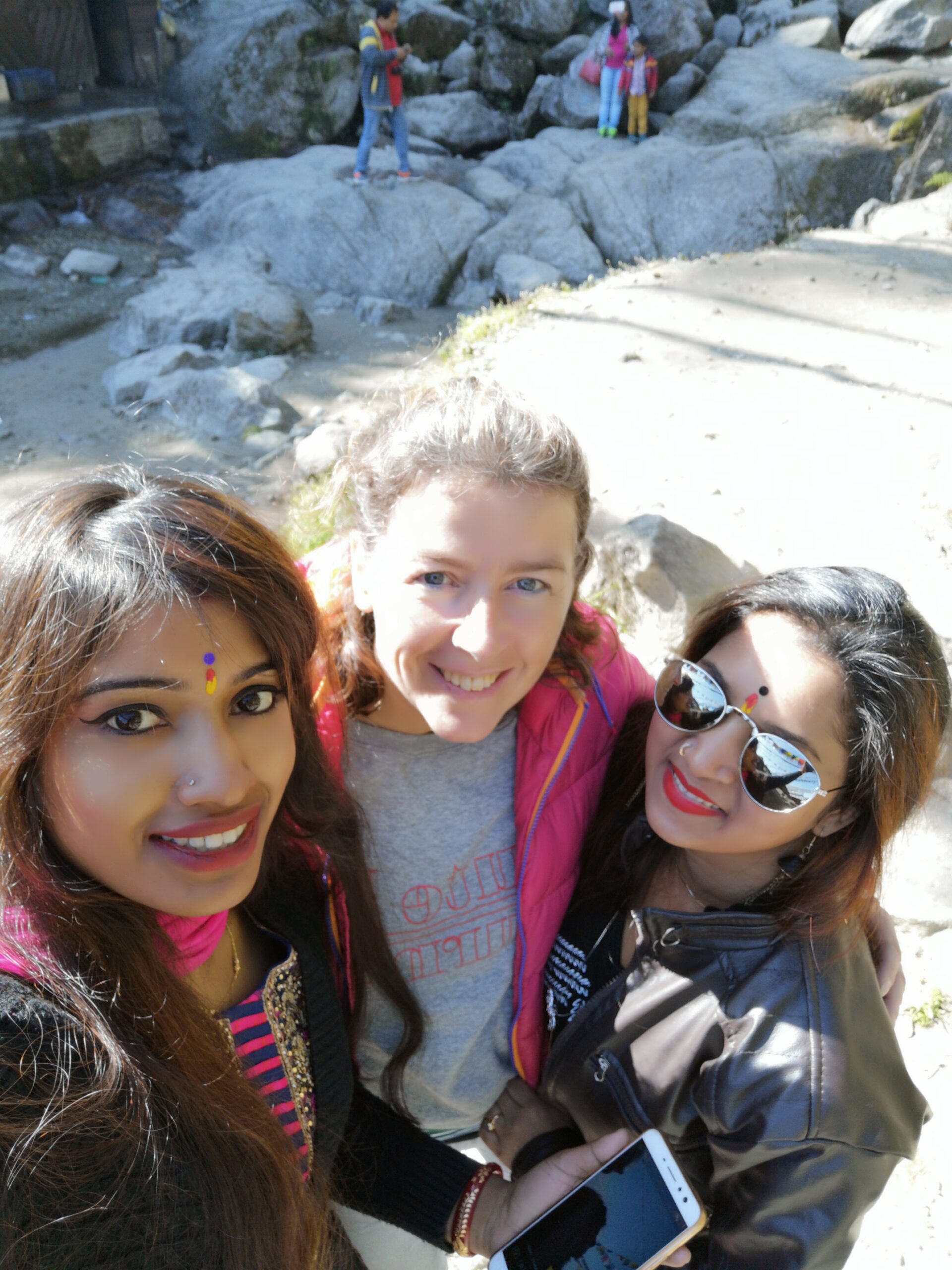
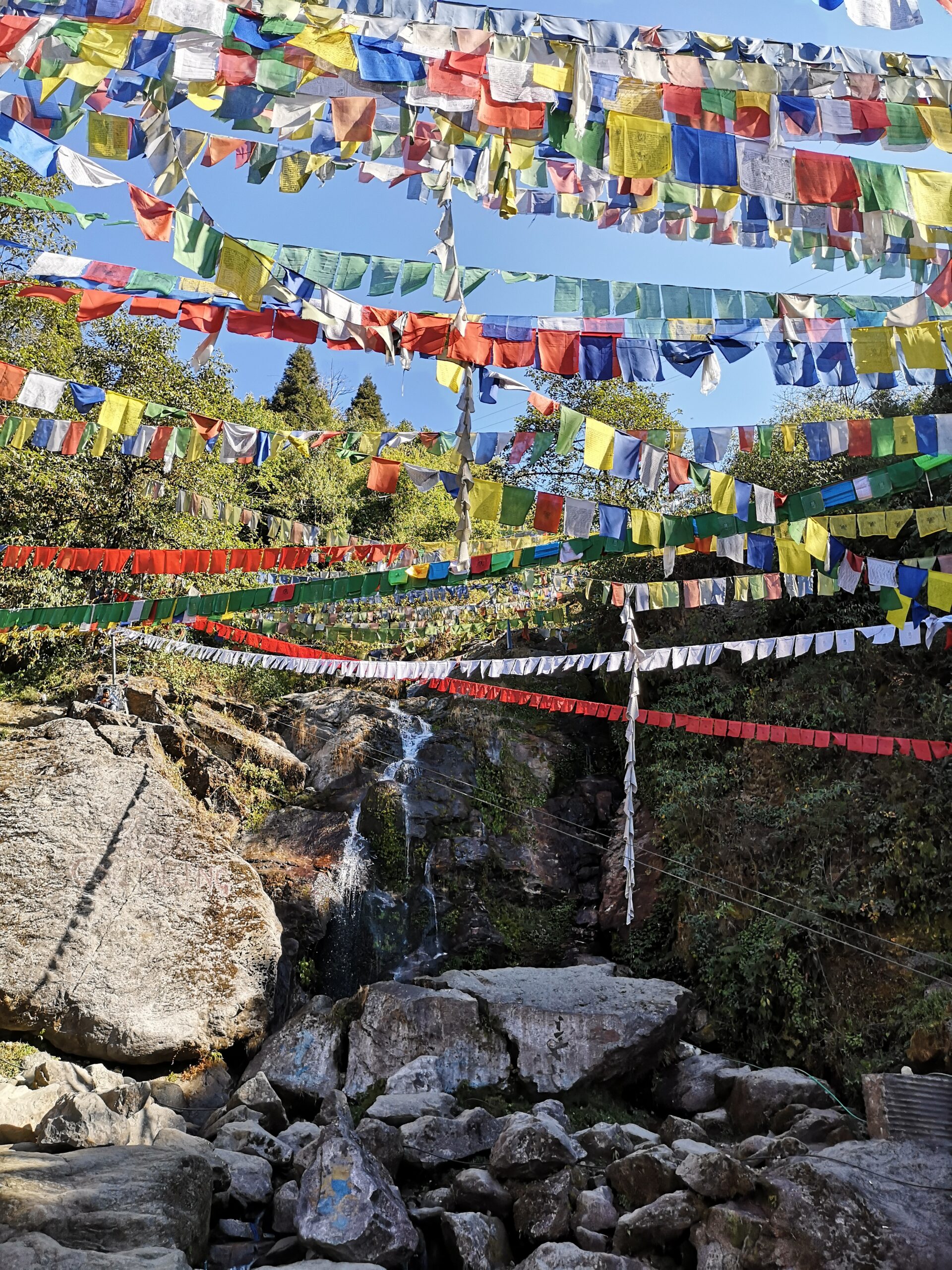
Plant Conservation Centre
For nature lovers, the Plant Conservation Centre is highly recommended. With an entrance fee of only €0.25, you can enjoy Sikkim’s rich flora, including rare orchids and alpine plants.
Downtown Gangtok: Modern and Clean
MG Marg: The Shopping Street
MG Marg (Mahatma Gandhi Marg) is the beating heart of Gangtok. This car-free shopping street offers everything your heart desires: from authentic Indian and Nepalese restaurants to clothing stores, souvenir shops, and jewelers.
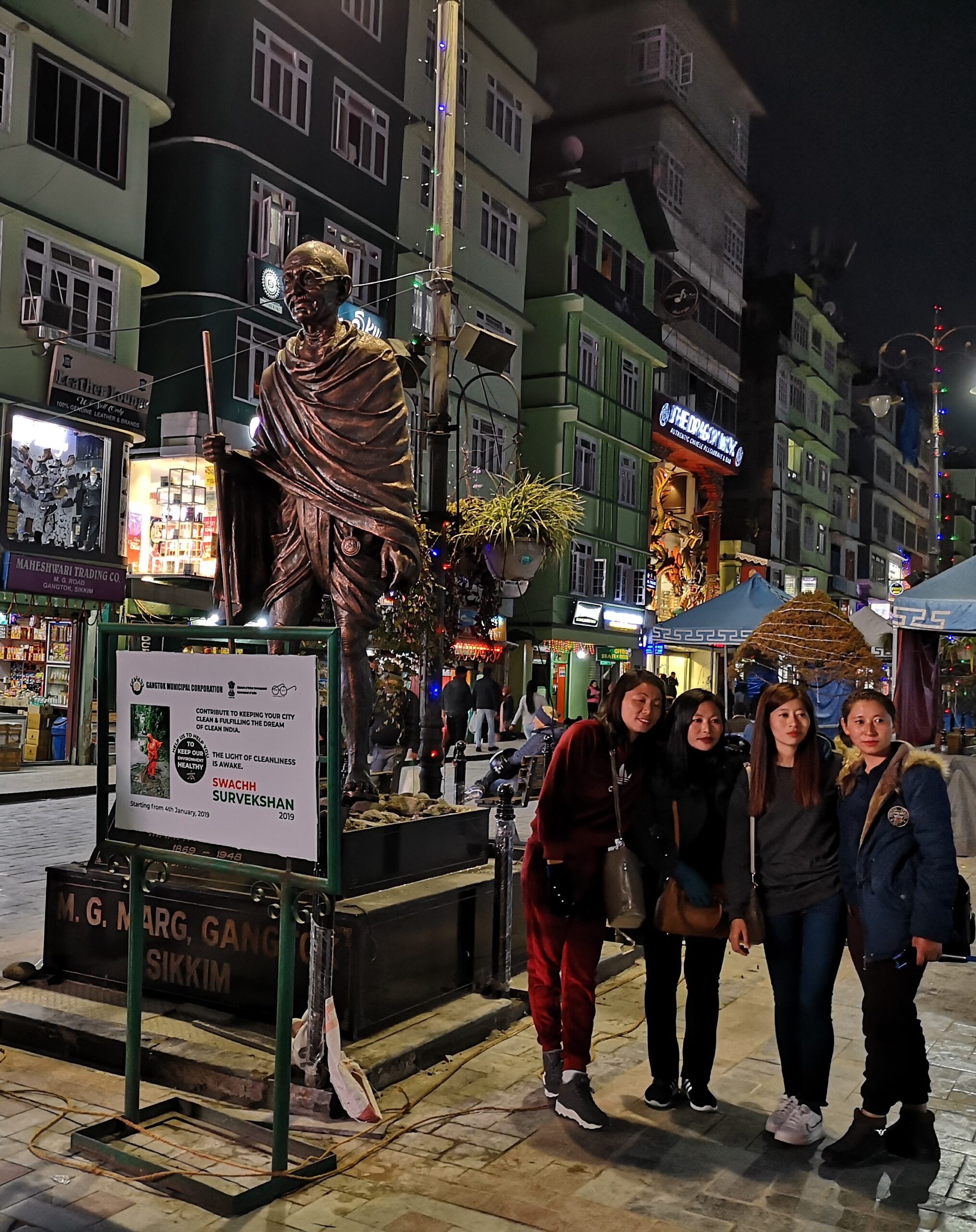
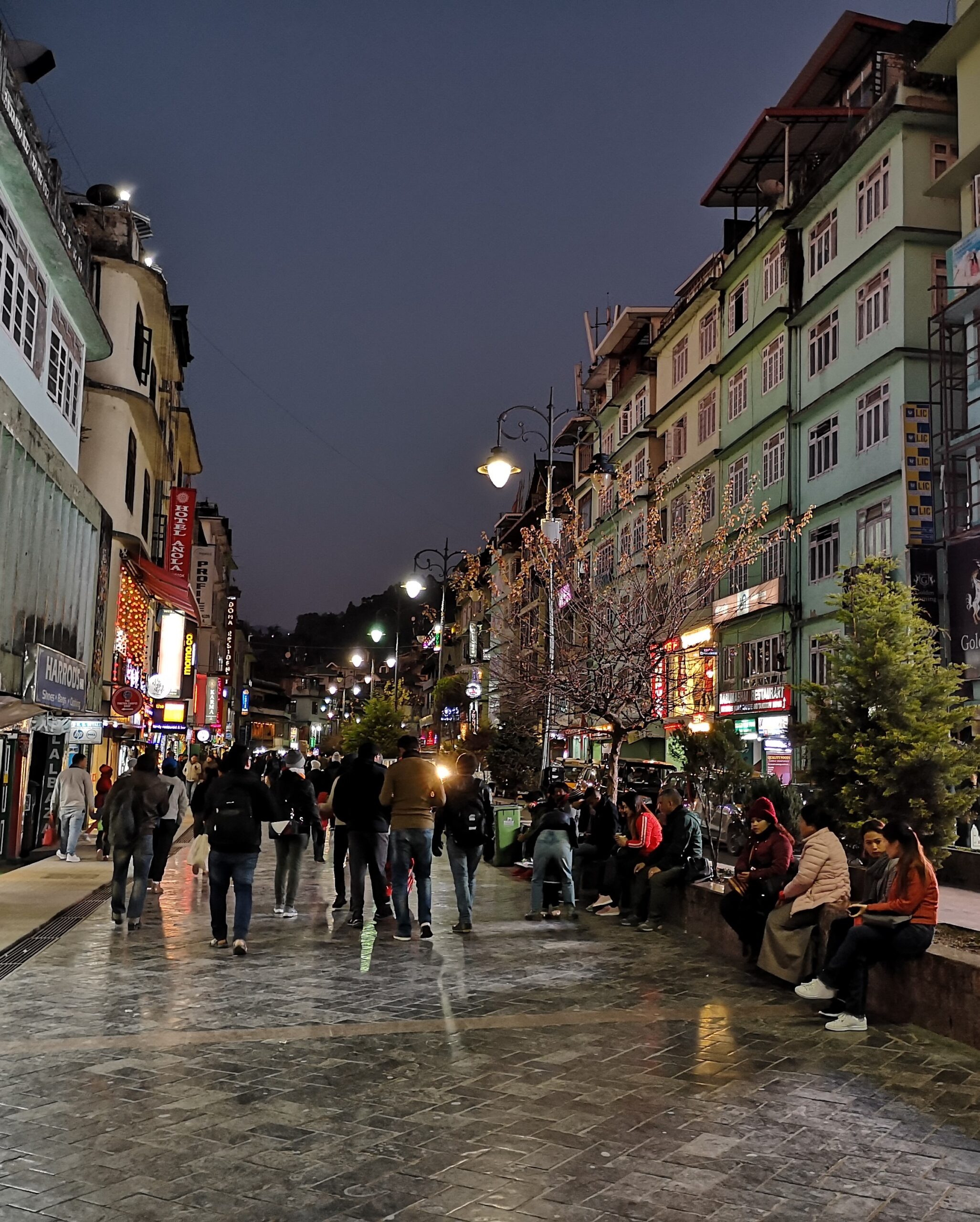
Dining on MG Marg: In the evening, the street comes alive with numerous dining establishments. Although you can also find pizzas and European dishes, I highly recommend enjoying the diverse Indian and Nepalese cuisine. With so many delicious options, you wouldn’t want to miss this rich culinary tradition!
Lal Bazaar: The Local Market
For an authentic experience, don’t skip Lal Bazaar. This partly touristic, partly local market is the place to do last-minute shopping, buy souvenirs, or simply experience the bustle of daily life in Gangtok.
A City with Rich History
Gangtok has a fascinating history closely tied to Sikkim’s development as a state. The city remained a small hamlet for centuries until Gangtok Monastery was built in 1716. The real transformation began in 1840 with the construction of Enchey Monastery, which made Gangtok an important pilgrimage site.
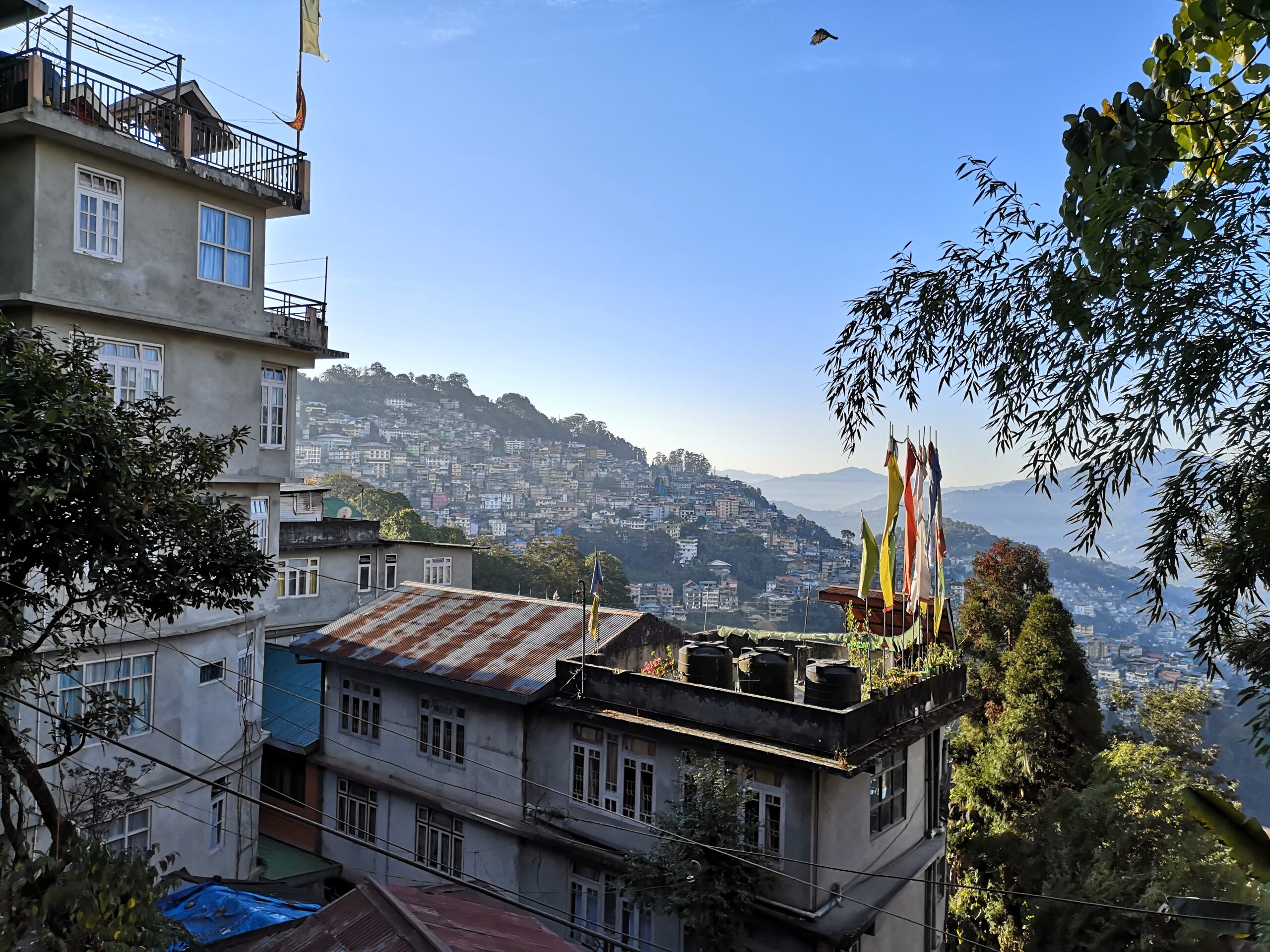
In 1894, the Sikkimese monarch Thutob Namgyal moved the capital from Tumlong to Gangtok, significantly increasing the city’s importance. After India’s independence in 1947, Sikkim became a nation-state with Gangtok as its capital, although it maintained its independence through a treaty with Prime Minister Jawaharlal Nehru.
After years of political unrest and riots, a referendum in 1975 abolished the monarchy and Sikkim became India’s 22nd state, with Gangtok as the official capital. This unique history makes Gangtok a city where ancient traditions meet modern developments.
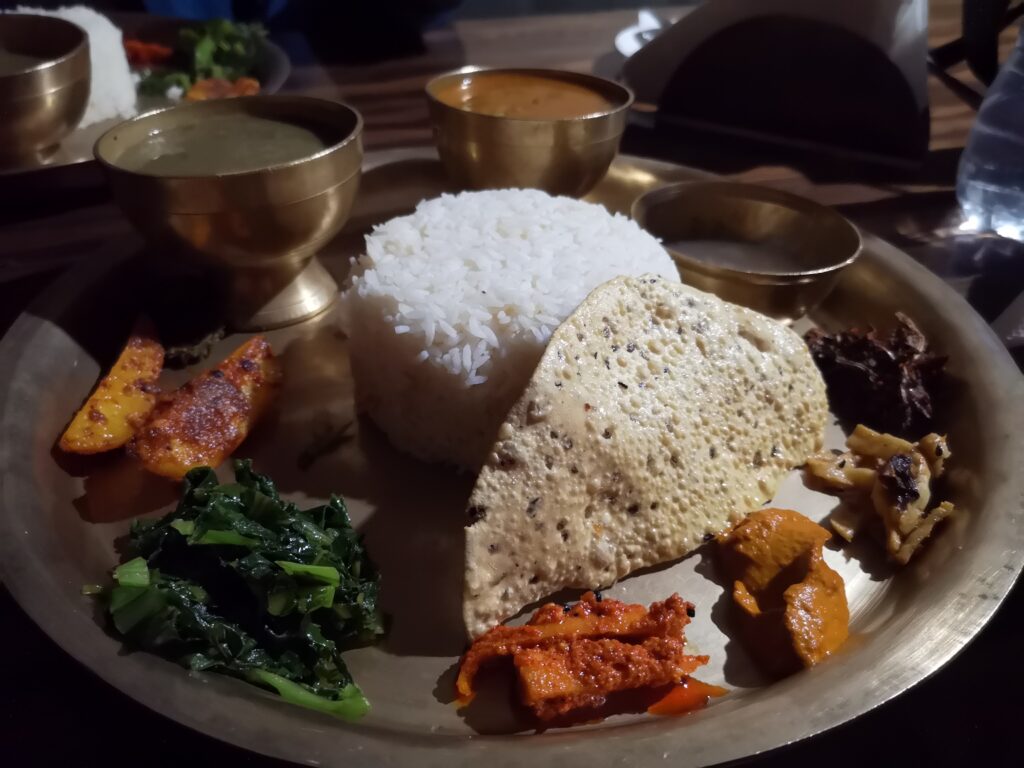
Special Features of Gangtok
A Smoke-Free City
Did you know that smoking on the streets is prohibited throughout Gangtok? This contributes to the remarkably clean streets. Not only the shopping street, but also the surrounding neighborhoods are notably well-maintained.
India’s Cleanest State
During my 10-day trip through Sikkim, it struck me again and again: Sikkim is by far the cleanest and best-maintained state in India. The contrast with other parts of the country is enormous. This makes traveling through Sikkim extra pleasant and demonstrates the environmental awareness of the local population.
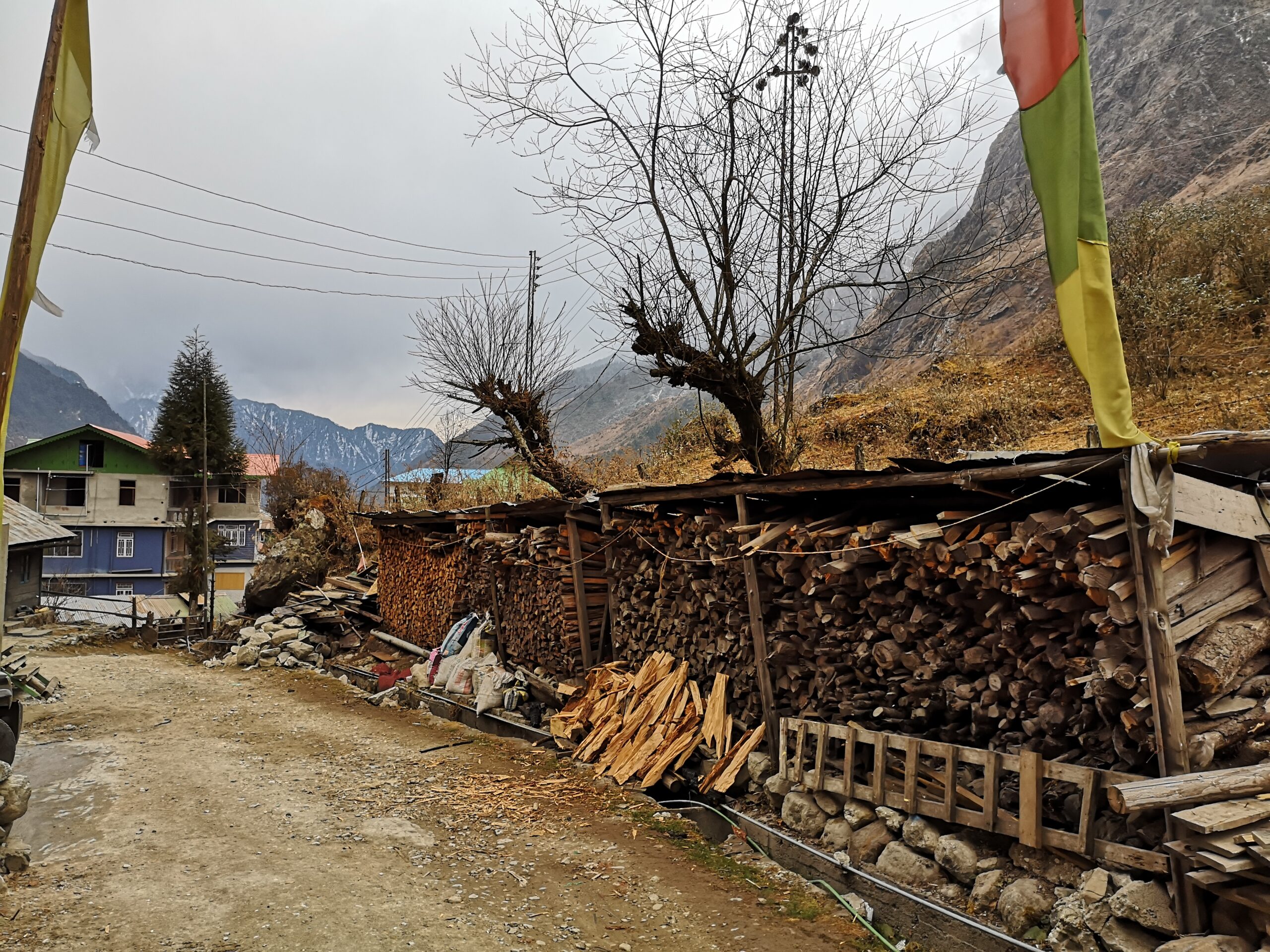
A Cultural Melting Pot
Gangtok’s population consists of three Sikkimese ethnic groups: the Bhutias, Lepchas, and Indian Gorkhas, supplemented by people from other Indian states. This diversity is reflected in the temples, monasteries, festivals, and daily culture of the city. Besides Buddhism and Hinduism, there are also Christian churches, mosques, and Sikh temples, making Gangtok a harmonious example of religious coexistence.
Accommodation in Gangtok
For backpackers and budget travelers, Tagalong Backpackers is a cozy hostel where you can meet other travelers and exchange tips about your trip through Sikkim. Gangtok also offers a wide range of accommodation options for every budget:
Budget (€5-15 per night):
- Hostels and guesthouses in the city center
- Homestays with local families (authentic experience!)
Mid-range (€15-45 per night):
- Very comfortable hotels with modern amenities
- Resorts just outside the center with mountain views
Luxury (€45+ per night):
Tip: Book accommodation near MG Marg for easy access to restaurants and shops, or choose a location with mountain views a bit further from the center for more peace and quiet.
Day Trips from Gangtok
Gangtok is the ideal base for tours to North Sikkim and West Sikkim. Consider an organized tour with Sikkim Cab Rental Co., which is familiar with permits and local regulations. From Gangtok, you can make multi-day trips to:
North Sikkim:
- Lachung and Lachen (picturesque mountain villages)
- Gurudongmar Lake (one of the highest lakes in the world at 5,183 meters)
- Yumthang Valley (the “Valley of Flowers” with hot springs)
West Sikkim:
- Pelling (with views of Kanchenjunga)
- Yuksom (the historic first capital of Sikkim, founded in 1642)
- Khecheopalri Lake (sacred lake for both Buddhists and Hindus)
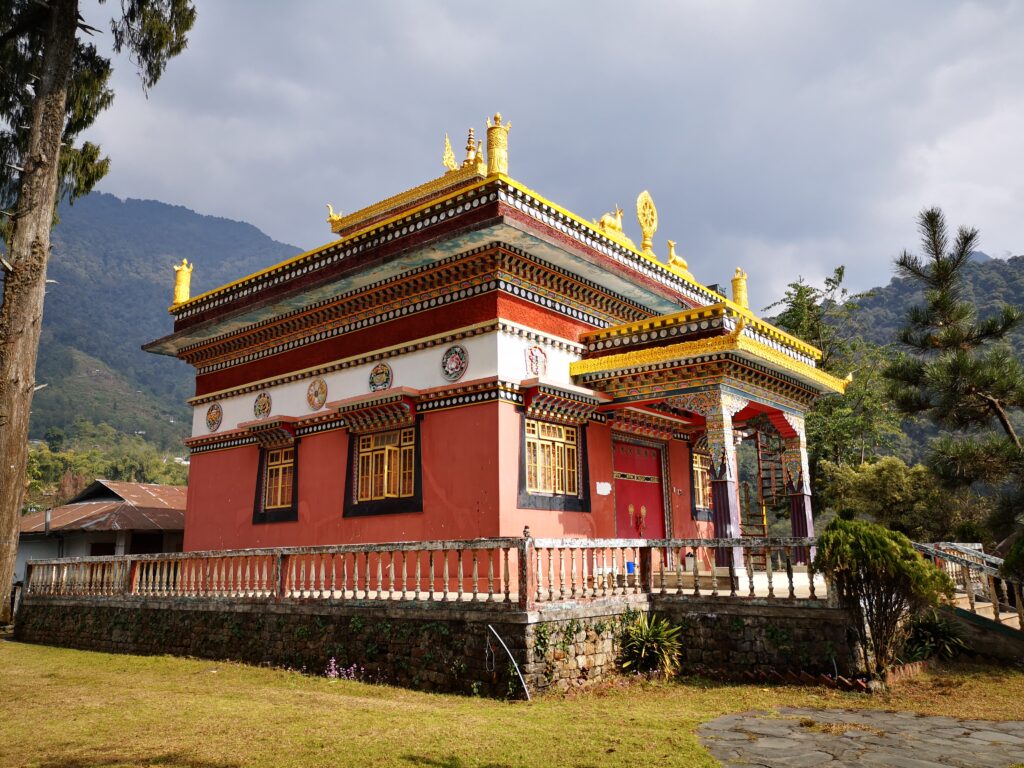
East Sikkim:
- Tsomgo Lake (also called Changu Lake, glacial lake at 3,753 meters altitude)
- Nathula Pass (Chinese border at 4,310 meters – accessible only to Indians, reopened in 2006 after years of closure since the Sino-Indian War in 1962)
- Baba Harbhajan Singh Temple
Best Time to Visit
January (as during my visit) can be chilly, especially in the morning, but as soon as the sun breaks through, it’s delightful. The best months to visit Gangtok are:
October – November: After the monsoon, clear weather, excellent mountain views March – May: Spring blossoms, blooming rhododendrons Avoid: Monsoon period (June – September) due to landslides
Festivals Worth Attending:
- Losar (Tibetan New Year) in January-February with the famous “Devil Dance”
- Pang Lhabsol (August-September) with masked dancers in honor of Kanchenjunga
- Buddha Jayanti (April-May) Buddha’s birthday
- Saga Dawa (May-June) most important Buddhist festival
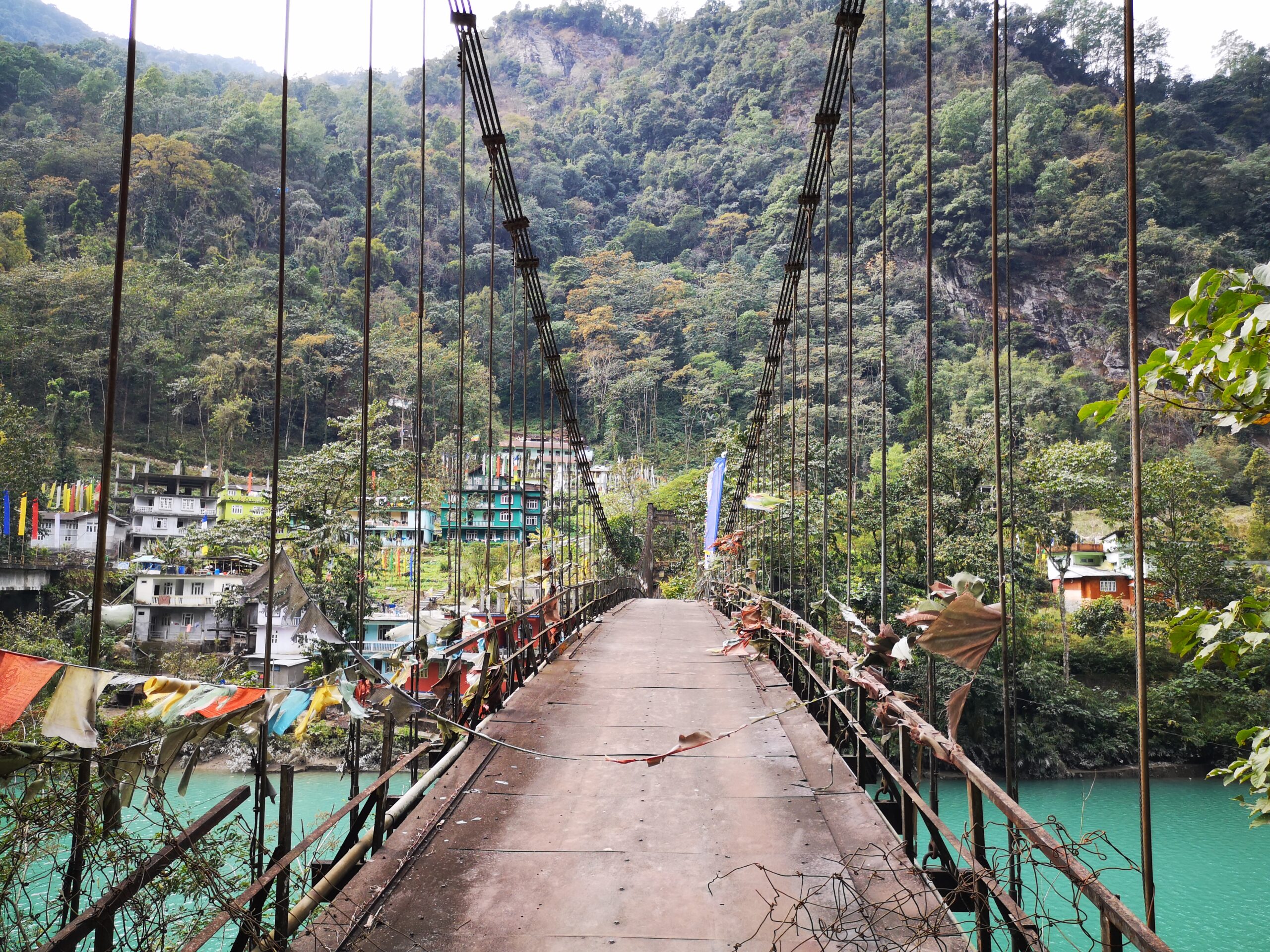
In Conclusion
Gangtok surprised me in many ways. It’s more than just a transit point to the higher regions of Sikkim – it’s a destination in itself. The combination of spiritual monasteries, spectacular mountain panoramas, a clean and modern city, and warm-hearted people make Gangtok an unforgettable stop on your journey through North India.
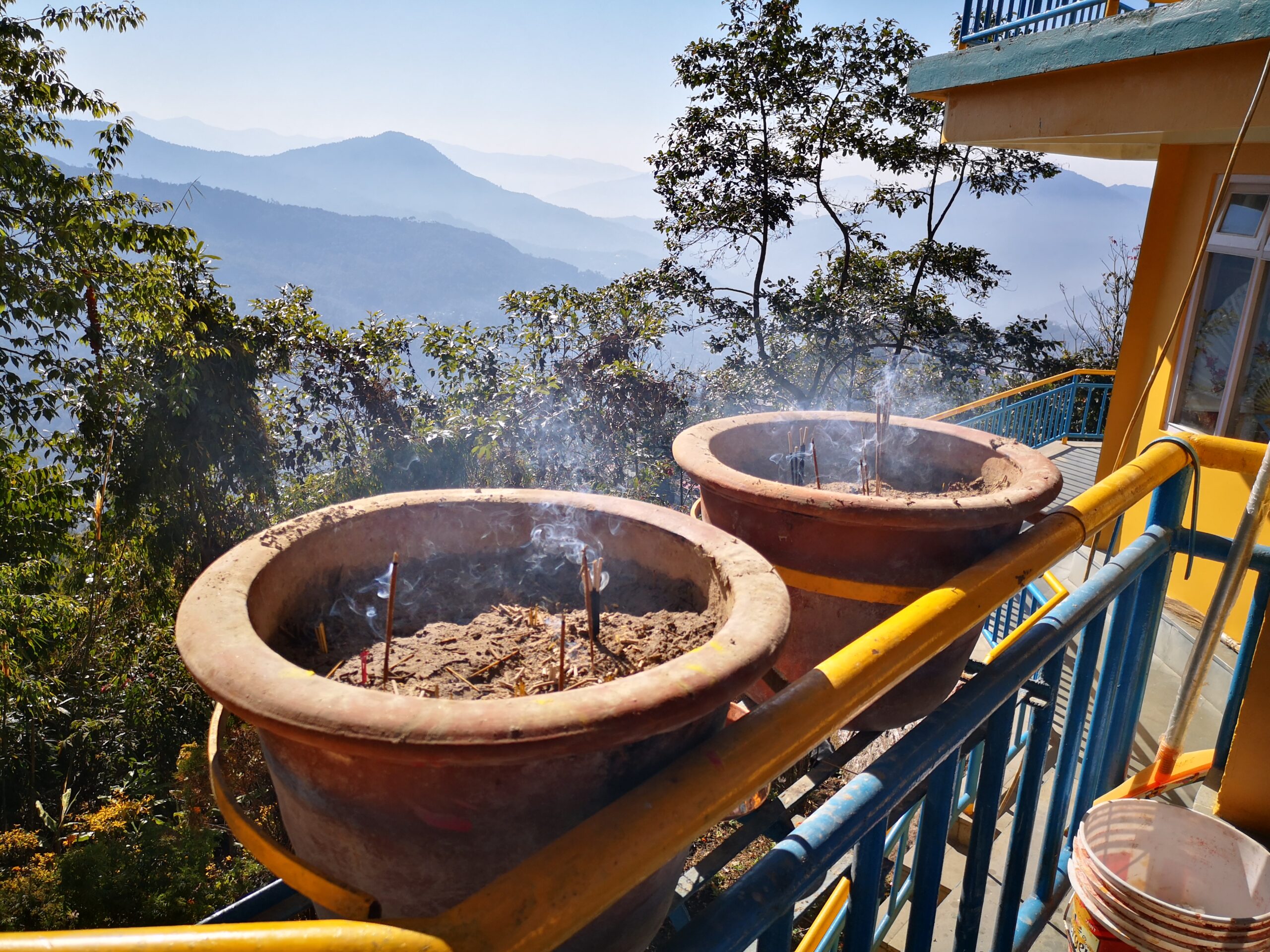
The diversity of cultures (Indian, Nepalese, Tibetan, and local Sikkimese influences) creates a unique atmosphere you won’t find anywhere else in India. Whether you come for the spiritual experience in the monasteries, the breathtaking nature, or simply to enjoy the relaxed atmosphere, Gangtok will pleasantly surprise you.
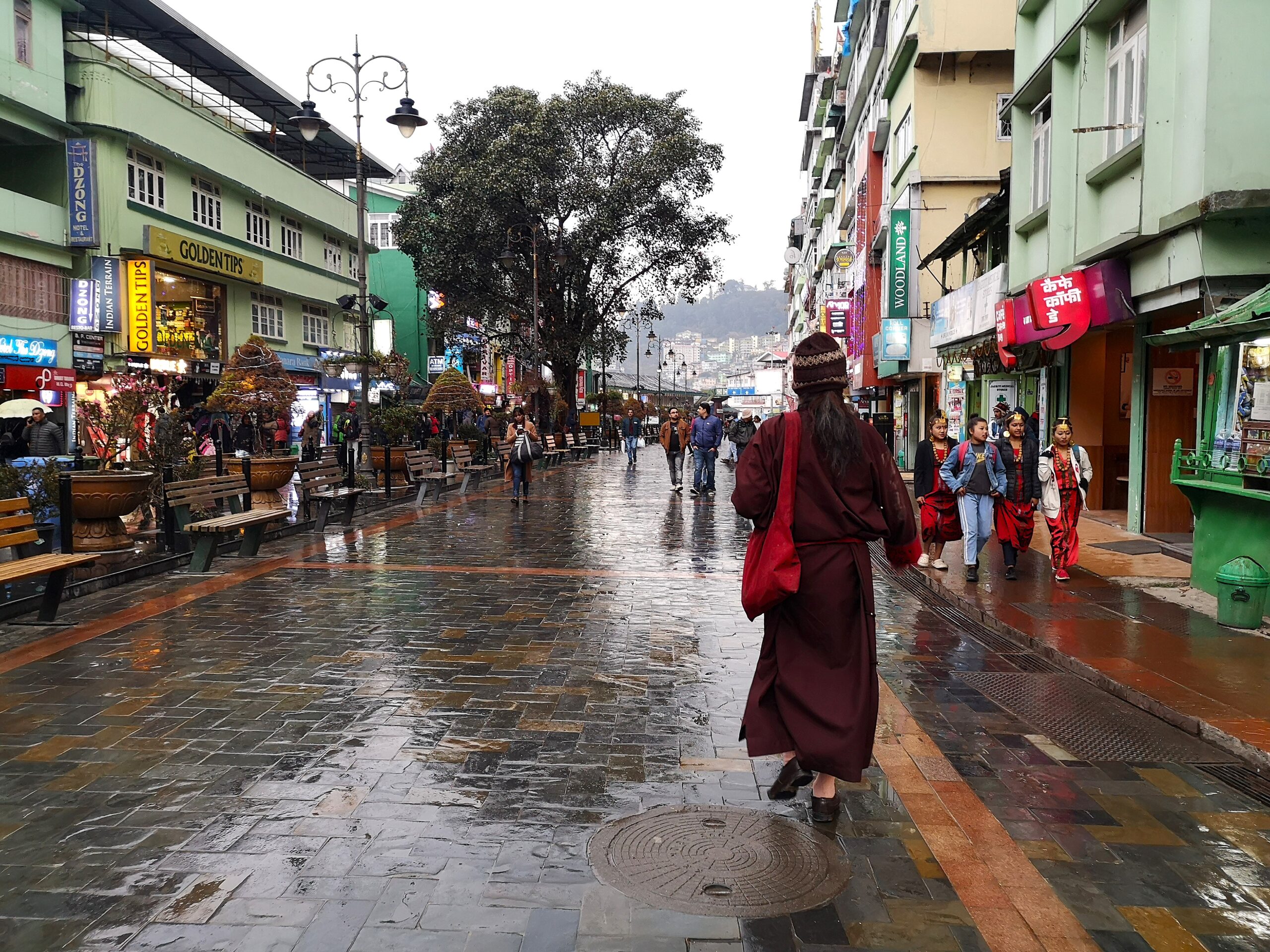
My tip: Take at least 2-3 days for Gangtok itself before moving on to the higher regions. The city deserves to be explored at your leisure, without rushing.
Also read;
